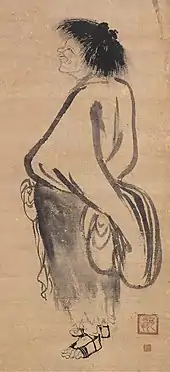Kaō (painter)
Kaō (可翁; fl. early 14th century) was a Japanese priest-painter whose work is considered typical of early Muromachi painting. He is especially known for his depiction of the legendary monk Kensu (Hsien-tzu in Chinese) at the moment he achieved enlightenment.[1] This type of painting was executed with quick brushstrokes and a minimum of detail.

Portrait of Kanzan
.jpg.webp)
Bamboo and a Sparrow
The biography of Kaō is largely unknown. He is commonly believed to have been a Japanese Zen monk who lived in China for more than ten years.[2] He entered monastic life at a young age and traveled towards the end of the Kamakura period.[3] Upon his return, it is believed that he became the abbot of a Zen temple.
References
- "Kaō Ninga | Japanese painter". Encyclopedia Britannica. Retrieved 2023-01-10.
- Aviman, Galit (2017-07-05). Zen Paintings in Edo Japan (1600-1868): Playfulness and Freedom in the Artwork of Hakuin Ekaku and Sengai Gibon. Routledge. p. 83. ISBN 978-1-351-53611-0.
- Dumoulin, Heinrich (2005). Zen Buddhism: Japan. World Wisdom, Inc. p. 234. ISBN 978-0-941532-90-7.
This article is issued from Wikipedia. The text is licensed under Creative Commons - Attribution - Sharealike. Additional terms may apply for the media files.